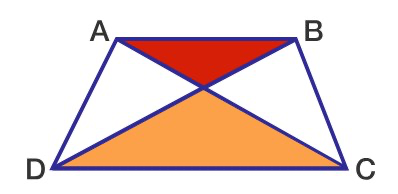Problems
Let \(AA_1\) and \(BB_1\) be the medians of the triangle \(\triangle ABC\). Prove that \(\triangle A_1B_1C\) and \(\triangle BAC\) are similar. What is the similarity coefficient?
Let \(AD\) and \(BE\) be the heights of the triangle \(\triangle ABC\), which intersect at the point \(F\). Prove that \(\triangle AFE\) and \(\triangle BFD\) are similar.
Let \(AD\) and \(BE\) be the heights of the triangle \(\triangle ABC\). Prove that \(\triangle DEC\) and \(\triangle ABC\) are similar.
The area of the red triangle is \(25\) and the area of the orange triangle is \(49\). What is the area of the trapezium \(ABCD\)?

Prove that the ratio of perimeters of similar polygons is equal to the similarity coefficient.
Let \(CB\) and \(CD\) be tangents to the circle with the centre \(A\), let \(E\) be the point of intersection of the line \(AC\) with the circle. Draw \(FG\) as the segment of a tangent drawn through the point \(E\) between the lines \(CB\) and \(CD\). Find the length \(|FG|\) if the radius of the circle is \(15\) and \(|AC| = 39\).
Prove that the relation between areas of two similar polygons equals to the square of their similarity coefficient.
In triangle \(\triangle ABC\) with right angle \(\angle ACB=90^{\circ}\), \(CD\) is the height and \(CE\) is the bisector. Draw the bisectors \(DF\) and \(DG\) of the triangles \(BDC\) and \(ADC\). Prove that \(CFEG\) is a square.
Today we will explore some mathematical games involving two players who take turns to move. In many games, one of the players has a winning strategy, which guarantees victory regardless of the opponent’s moves.
Let’s say you are at a stage of the game where you can win in one move and it is also your turn. Then that position is called a winning position. We can now make the following definition for all states of the game.
A losing position is one where all your moves give the other player a winning position. A winning position is one where you can make a move that gives your opponent a losing position.
We can analyse from the end of the game backwards and figure out whether each possible state is a winning position or a losing position. The first player has a winning strategy if the starting position is a winning position. The winning strategy belongs to the second player if the starting position is a losing position.
Karl and Louie are playing a game. They place action figures around a round table with 24 seats. No two figures are allowed to sit next to each other, regardless of whether they belong to Karl or Louie. The player who cannot place their figure loses the game. Karl goes first - show that Louie can always win.